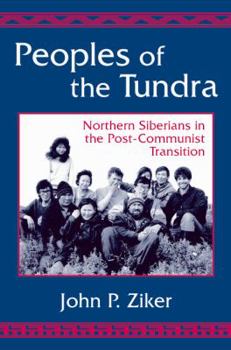Peoples of the Tundra: Northern Siberians in the Post-Communist Transition
On ethnographic grounds alone, Ziker's book is a unique and valuable contribution. Despite increased fieldwork opportunities for foreigners in the former Soviet Union in recent years, much of Russia... This description may be from another edition of this product.
Format:Paperback
Language:English
ISBN:1577662121
ISBN13:9781577662129
Release Date:March 2002
Publisher:Waveland Press
Length:197 Pages
Weight:0.65 lbs.
Dimensions:1.3" x 8.5" x 11.0"
Related Subjects
Anthropology Political Science Politics & Social Sciences Social Science Social SciencesCustomer Reviews
1 rating
Book of the Month
Published by Thriftbooks.com User , 19 years ago
1 May 2003 Gail Fondahl, University of Northern British Columbia John Ziker's Peoples of the Tundra provides an informative account of post-Soviet adaptations in the remote indigenous community of Ust-Avam on the Taymyr penisula. He suggests that, counter to global trends of even remote communities becoming increasingly linked with the world economy, in this region, isolation and independence is on the rise. Ziker pays specific attention to the evolution of property rights and land use, noting the significant disjunction between new legal provisions for land rights, and preferred property arrangements in situ. Ust-Avam, populated mainly by Dolgans, Nganasans and Russians, has watched its connections to the `outside' atrophy, as the state has withdrawn transportation subsidies, and as the hunting enterprise which organized economic activities during the Soviet period has languished. Some scholars have argued that the post-Soviet transition toward a market economy will mean a partial return to `traditional' ways of life (e.g., Pika 1999). The Russian government in fact has allowed for land claims to be pursued on the basis of what some ethnographers have argued was the predominant pre-Soviet indigenous land tenure system, founded around the obshchina. Ziker asks why few native families have pursued such obshchina lands, and why most have made no attempt to gain formal title to land in this part of Russia. This is the core theme of his book; however his broader intent is to introduce the Dolgans and Nganasans, peoples poorly documented in the English language. Ziker has directed his book toward an undergraduate anthropology audience, aware that it will also attract scholars of indigenous peoples in Russia. After outlining his general argument, he introduces the geography and basic economy of the region, focussing especially on the diversity of hunting techniques and hunted species. We then receive a historical overview of changing property relations in Taymyr since Russian penetration, with emphasis on the Soviet period of settlement and collectivization. The Volochanka Rebellion, a long-shrouded example of resistance to early Sovietization, is covered more thoroughly here than in other English-language sources (cf. Anderson 2000, Golovnev and Osherenko 1999). Ziker also underscores how many Native individuals view the late Soviet as the golden age - though he might have accentuated for an undergraduate audience that this remembering and re-presentation of that period must be considered in the face of current woes. Chapter 4, curiously titled "Alcohol and Violent Death' records a much more comprehensive story of demographic changes in Ust Avam. Ziker reveals a substantially reduced birth rate since 1993. His discussion of mortality exposes differences along axes of gender and ethnicity: especially interesting is the comparison of Dolgan and Nganasan mortality. The grim picture of increased alcohol abuse, foreshadowed in the chapter's title, i




